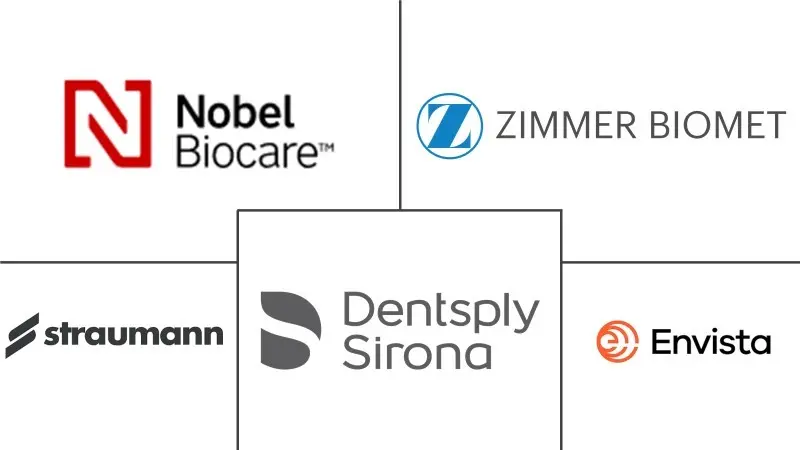Abutment Implants Market Size and Share
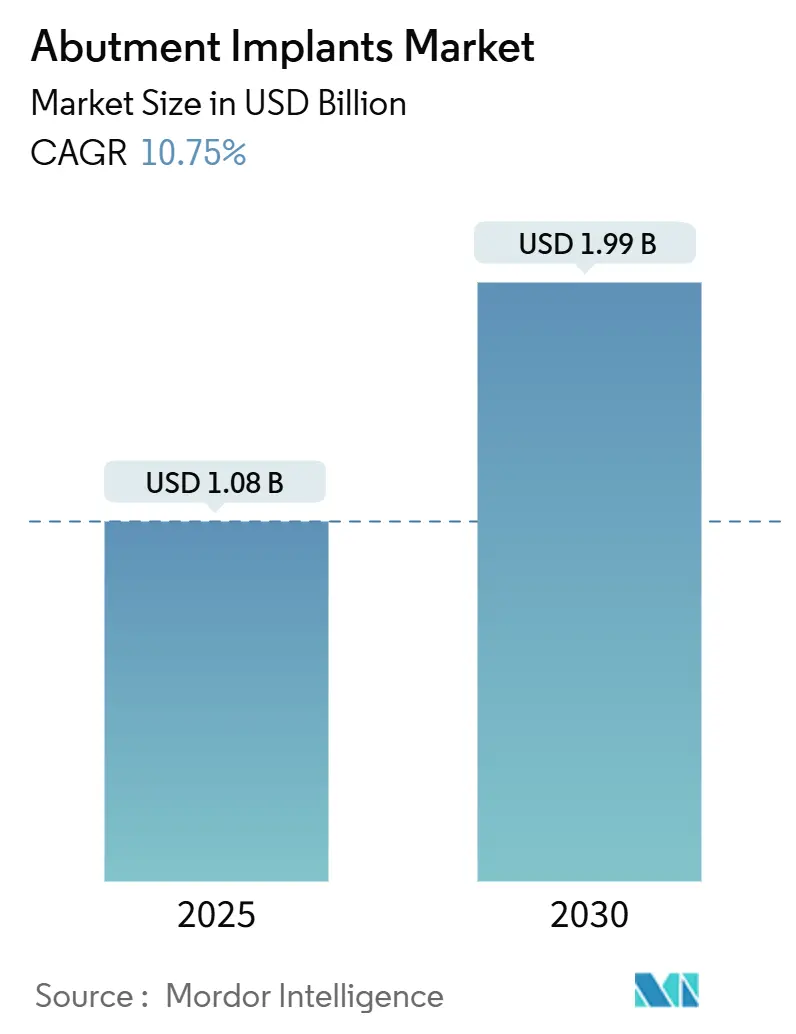
Abutment Implants Market Analysis by Mordor Intelligence
The abutment implants market generated USD 1.08 billion in 2024 and is on track to reach USD 1.99 billion by 2030, advancing at a 10.75% CAGR from 2025 to 2030. Steady expansion is underpinned by population ageing, fast-growing adoption of digital workflows, and rising patient expectations for metal-free, highly aesthetic restorations. Implant volumes continue to climb as edentulism prevalence accelerates among older adults, while rapid uptake of intraoral scanning, CAD/CAM, and 3-D printing shortens treatment times and elevates customization accuracy. Material innovation, led by zirconia and high-performance polymers, is broadening clinical options beyond legacy titanium. Meanwhile, insurance code additions and value-based care policies are gradually widening reimbursement coverage, encouraging clinicians to recommend implant-supported therapies over removable alternatives. Competitive dynamics are shifting as global leaders scale local manufacturing, pursue M&A to strengthen digital portfolios, and deploy AI-driven design tools that differentiate chair-side workflows.
Key Report Takeaways
- By material, titanium led with 78.20% revenue share in 2024, while zirconia is projected to expand at an 11.98% CAGR through 2030.
- By abutment type, prefabricated solutions held 62.26% of the abutment implants market share in 2024, whereas customized designs are forecast to grow at 12.39% CAGR to 2030.
- By end-user facility, dental clinics accounted for 46.50% share of the abutment implants market size in 2024; dental laboratories are advancing at a 12.81% CAGR to 2030.
- By geography, Europe dominated with 31.43% revenue share in 2024, while Asia-Pacific is rising fastest at 13.25% CAGR over 2025-2030.
Global Abutment Implants Market Trends and Insights
Driver Impact Analysis
| Driver | (~) % Impact on CAGR Forecast | Geographic Relevance | Impact Timeline |
|---|---|---|---|
| Aging-related edentulism prevalence | +2.8% | Global, with concentration in North America & Europe | Long term (≥ 4 years) |
| Cosmetic dentistry demand for zirconia esthetics | +1.9% | Global, particularly North America & EMEA premium markets | Medium term (2-4 years) |
| Digital CAD/CAM & 3-D printing penetration | +2.1% | Global, led by North America & Europe, expanding to APAC | Medium term (2-4 years) |
| Reimbursement expansion for implant components | +1.7% | North America & Europe, selective APAC markets | Long term (≥ 4 years) |
| AI-driven chair-side custom-abutment design | +1.4% | North America & Europe early adoption, APAC following | Short term (≤ 2 years) |
| Low-cost 3-D-printed PEEK abutments in Asia-Pacific | +0.8% | APAC core, spill-over to MEA | Medium term (2-4 years) |
| Source: Mordor Intelligence | |||
Aging-Related Edentulism Prevalence Accelerates Demand
Global edentulism prevalence climbs steeply with age; Canadian data show a rise from 6.4% overall to 21.7% in adults aged 60-79 years, echoing similar patterns across developed economies. Higher tooth loss intersects with growing disposable incomes, creating a sizeable cohort willing to pay for implant-supported restorations rather than removable prostheses. The WHO’s Global Oral Health Action Plan highlights more than 280 million older adults affected by oral disorders, reinforcing the policy focus on restorative solutions. Together these factors widen the addressable base for the abutment implants market.
Cosmetic Dentistry Demand for Zirconia Esthetics
Surveys reveal that close to 80% of patients prefer zirconia implants because of tooth-like translucency and reduced allergenicity, despite titanium’s deep evidence base. Clinical trials confirm monolithic zirconia crowns exhibit fewer technical complications over two-year follow-up than metal-ceramic equivalents. With CAD/CAM and additive manufacturing enhancing machining precision, zirconia’s growth trajectory remains strong in the abutment implants market.
Digital CAD/CAM & 3-D Printing Penetration
Fifty-five percent of dentists now use intraoral scanners, 50% rely on 3-D printing, and 36% employ CAD/CAM, embedding digital capability throughout the care continuum[1]Source: American Dental Association, “Survey of Dental Practice 2025,” ada.org . Same-day workflow adoption accelerates clinical turnaround, while AI integration improves margin design accuracy and reduces remakes[2]Source: Cigna Healthcare, “AI Adoption in Dental Care 2025,” cigna.com . Reduced material waste and mass customization make digital abutments accessible to smaller practices, reinforcing demand growth.
Reimbursement Expansion for Implant Components
The 2025 CDT update introduced codes such as D6180 and D6193, signalling mainstream recognition of implant therapy in the United States. European payers already reimburse abutment components under defined indications, setting precedents that inform policy in Asia-Pacific markets. Broader coverage lowers out-of-pocket costs and stimulates procedure volumes across the abutment implants market.
Restraint Impact Analysis
| Restraint | (~) % Impact on CAGR Forecast | Geographic Relevance | Impact Timeline |
|---|---|---|---|
| High procedure cost & limited insurance cover | -1.8% | Global, particularly acute in developing markets | Long term (≥ 4 years) |
| Shortage of trained implantologists in LICs | -1.2% | Low-income countries, rural areas globally | Long term (≥ 4 years) |
| Peri-implant disease revision burden rising | -0.9% | Global, higher in markets with established implant populations | Medium term (2-4 years) |
| Raw-material ESG pressures on Ti/Zr supply | -0.6% | Global supply chains, concentrated in mining regions | Medium term (2-4 years) |
| Source: Mordor Intelligence | |||
High Procedure Cost & Limited Insurance Cover
Comprehensive implant treatment often costs USD 3,000–5,000 per tooth in developed countries, challenging affordability for uninsured patients. Coverage gaps persist because many insurers still classify implants as cosmetic. Currency fluctuations further complicate affordability in emerging economies that rely on USD-denominated component imports. These economic barriers curb potential uptake within the abutment implants market.
Shortage of Trained Implantologists in LICs
Specialised training is insufficient in low-income countries, and professional migration to wealthier regions aggravates skill shortages. Digital workflows demand proficiency in imaging, CAD, and material science that general practitioners often lack. Manufacturer-led education, such as DS Academy’s restorative courses, helps but remains limited in reach. Rural areas in high-income nations face similar access issues, underscoring an uneven distribution of implant expertise worldwide.
Segment Analysis
By Material: Zirconia Gains Ground Despite Titanium Dominance
Titanium maintained 78.20% of the abutment implants market share in 2024 because of long-term biocompatibility proof and reliable osseointegration. The abutment implants market size for zirconia abutments is projected to expand at 11.98% CAGR between 2025 and 2030, buoyed by increasing aesthetic expectations. Zirconia implants achieve satisfactory survival rates and present fewer soft-tissue discoloration issues than titanium, making them popular in the anterior zone. Stress-modulating polymers such as PEEK form a niche but fast-evolving class that lowers bone loading by 26% in finite-element analyses.
Patient-specific factors increasingly drive material selection. Titanium hypersensitivity, though uncommon, prompts clinicians to consider ceramic alternatives, while surface modifications like laser texturing and nanoparticle coatings improve both titanium and zirconia healing characteristics. Competitive differentiation is thus shifting from base alloy alone to engineered surfaces that accelerate soft-tissue integration and resist bacterial colonisation.

Note: Segment shares of all individual segments available upon report purchase
By Abutment Type: Customization Transforms Traditional Workflows
Prefabricated components delivered 62.26% of 2024 revenue thanks to immediate availability and lower unit cost. Yet customised designs dominate growth; the abutment implants market size for custom abutments is forecast to advance at 12.39% CAGR through 2030. Clinical studies show customised healing abutments foster superior peri-implant soft-tissue outcomes and emergence profiles compared with standard designs. Multi-unit abutments, crucial in full-arch restorations, gain momentum as clinicians embrace All-on-4 and other immediate-loading protocols.
Digital fabrication democratises custom abutments through streamlined CAD/CAM processes. AI-driven design platforms predict soft-tissue behaviour and automate margin contouring, cutting chair-side adjustment time. Prefabricated options, meanwhile, continue to evolve via enhanced surface treatments that improve cement retention and soft-tissue conditioning, safeguarding their relevance in cost-sensitive segments of the abutment implants market.
By End-User Facility: Laboratories Drive Digital Transformation
Dental clinics generated the largest revenue share at 46.50% in 2024. Dental laboratories, however, are projected to record the fastest 12.81% CAGR to 2030 as practices outsource complex digital fabrication to centralised hubs equipped with high-throughput milling units and multi-material printers. Centralised production fosters quality control, allows bulk raw-material purchasing, and spreads machine amortisation across higher volume.
Integration between chair-side scanners and lab design software shortens turnaround times and eliminates analog impression errors. Laboratories also leverage AI-powered nesting algorithms to optimise material usage, trimming waste and lowering per-unit costs. Hospitals and academic centres contribute steady demand for specialised abutments in reconstructive surgery and clinical trials, yet their absolute volume remains modest relative to independent practices and DSOs that dominate routine implant therapy in the abutment implants market.
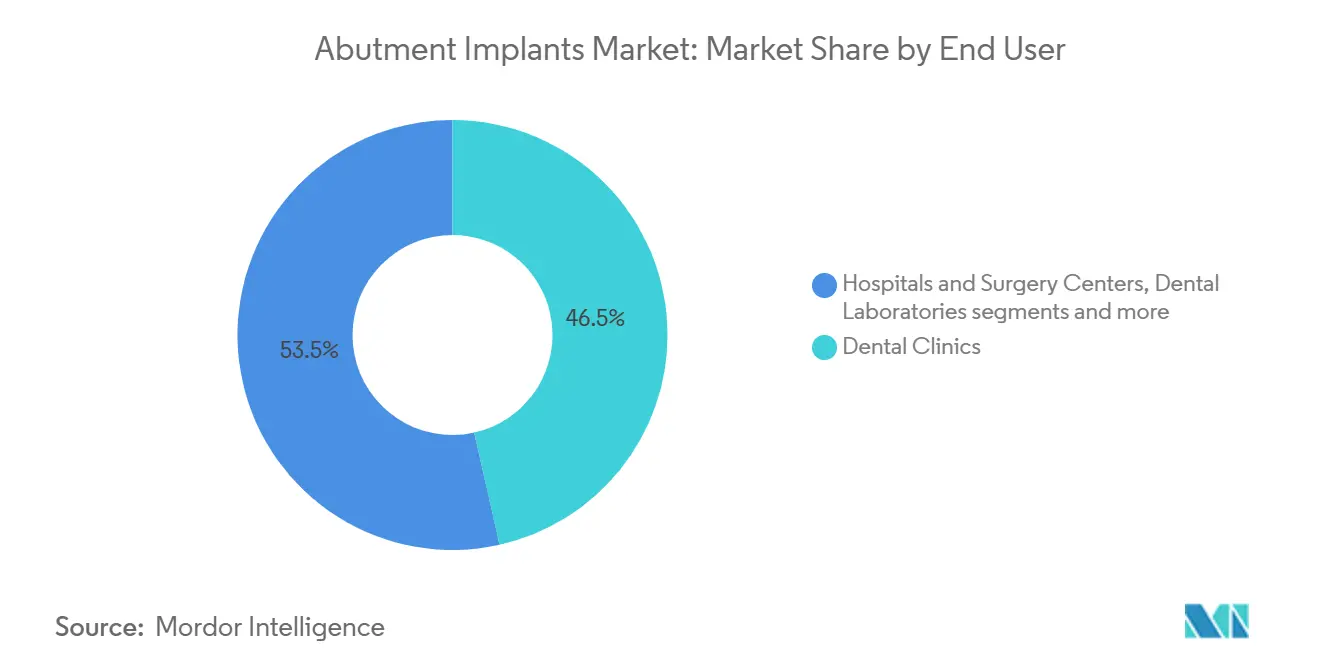
Note: Segment shares of all individual segments available upon report purchase
Geography Analysis
By Geography: Asia-Pacific Emerges as Growth Engine
Europe captured 31.43% of 2024 revenue, benefiting from established reimbursement frameworks, dense specialist networks, and strong patient purchasing power. Asia-Pacific records the highest 13.25% CAGR thanks to rapid economic development, burgeoning middle-class demand, and expanding dental tourism hotspots. Local manufacturing hubs in China, South Korea, and India reduce import duties and logistics costs, enabling more competitive pricing for abutments that meet international quality standards.
North America sees stable yet moderating unit growth, as mature markets approach saturation in certain metro areas, though digital adoption remains the highest globally. Latin America delivers robust volume through value-oriented local brands; Straumann’s Neodent expansion highlights this trend with new Brazilian capacity aimed at regional export. In the Middle East and Africa, rising private healthcare investment and government-backed tourism initiatives unlock new patient pools, but currency volatility and regulatory fragmentation continue to temper near-term expansion for the abutment implants market.
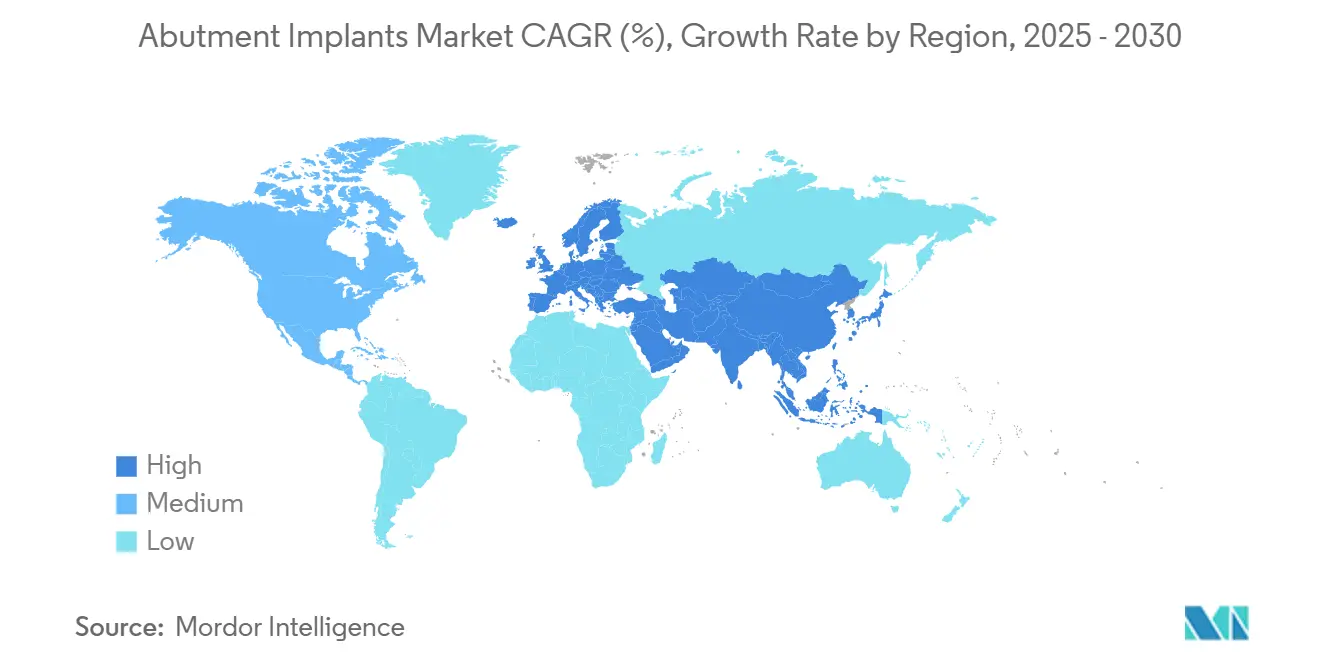
Competitive Landscape
The abutment implants market is moderately consolidated, with the five largest suppliers controlling about 55% of global revenue. Straumann leads through a vertically integrated digital ecosystem, reporting 16.1% organic revenue growth in Q2 2024 and consistently launching scanners, printer collaborations, and surface-modified implant lines. Dentsply Sirona, Osstem, ZimVie, and Envista round out the top tier, each investing in AI design modules and cloud-linked software that lock practitioners into proprietary platforms.
Strategic M&A remains a core route to scale. Osstem’s advanced negotiations to acquire ZimVie would combine complementary regional strengths, creating a challenger better able to negotiate raw-material contracts and fund R&D. Smaller innovators carve niches in polymer abutments, narrow-diameter indications, and specialist regenerative coatings. Patent filings around laser surface structuring, antibacterial nanotopography, and machine-learning-guided design underline a competitive emphasis on technology-enabled clinical outcomes rather than price alone.
Supply chain resilience is receiving heightened attention in the wake of extended shipping lead times and geopolitical risk. Multinationals are hedging by localising production in key growth territories to minimise currency swings and shorten delivery cycles. A growing number of firms is also setting carbon-reduction targets that influence material sourcing and energy-efficient manufacturing choices, aligning with ESG demands from institutional investors that view environmental credentials as a proxy for long-term operational robustness in the abutment implants market.
Abutment Implants Industry Leaders
-
Nobel Biocare
-
Dentsply Sirona
-
Straumann Group
-
Envista
-
Zimmer Biomet
- *Disclaimer: Major Players sorted in no particular order
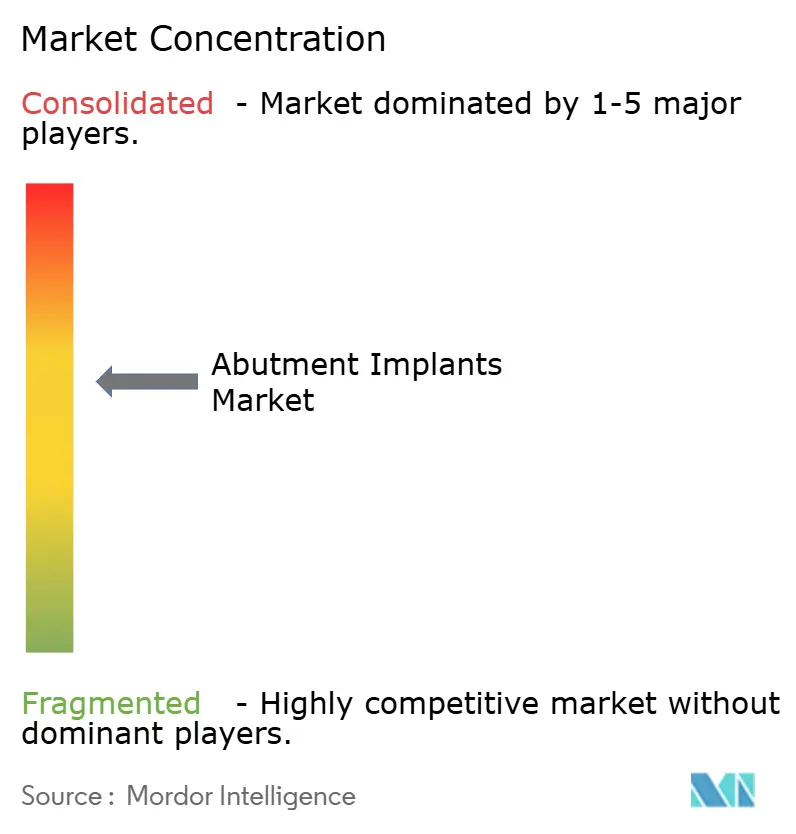
Recent Industry Developments
- January 2025: Tufts University researchers unveiled a biodegradable coating for implants that promotes nerve tissue regrowth, potentially restoring sensory feedback in prosthetic teeth
- October 2024: The FDA issued final guidance titled “Endosseous Dental Implants and Endosseous Dental Implant Abutments—Performance Criteria for Safety and Performance Based Pathway,” standardising review parameters for new devices.
- July 2024: Osstem Implant entered advanced talks to buy ZimVie, signalling further consolidation among leading suppliers
Global Abutment Implants Market Report Scope
As per the scope of this report, Abutment is a metal connector that a dental professional installs into the patient's dental implant for healing from dental surgery. The Abutment Implants Market is segmented by Type (Prefabricated Abutment systems and Custom Abutment Systems) and Geography (North America, Europe, Asia-Pacific, and the Rest of the World). The market report also covers the estimated market sizes and trends for 17 different countries across major regions, globally. The report offers the value (in USD million) for the above segments.
| Titanium |
| Zirconia |
| PEEK & High-performance Polymers |
| Hybrid/Composite Alloys |
| Prefabricated |
| Customized |
| Healing |
| Multi-Unit |
| Dental Clinics |
| Hospitals & Surgery Centers |
| Dental Laboratories |
| Academic & Research Institutes |
| North America | United States |
| Canada | |
| Mexico | |
| Europe | Germany |
| United Kingdom | |
| France | |
| Italy | |
| Spain | |
| Rest of Europe | |
| Asia-Pacific | China |
| India | |
| Japan | |
| South Korea | |
| Australia | |
| Rest of Asia-Pacific | |
| South America | Brazil |
| Argentina | |
| Rest of South America | |
| Middle East and Africa | GCC |
| South Africa | |
| Rest of Middle East and Africa |
| By Material | Titanium | |
| Zirconia | ||
| PEEK & High-performance Polymers | ||
| Hybrid/Composite Alloys | ||
| By Abutment Type | Prefabricated | |
| Customized | ||
| Healing | ||
| Multi-Unit | ||
| By End-user Facility | Dental Clinics | |
| Hospitals & Surgery Centers | ||
| Dental Laboratories | ||
| Academic & Research Institutes | ||
| By Geography | North America | United States |
| Canada | ||
| Mexico | ||
| Europe | Germany | |
| United Kingdom | ||
| France | ||
| Italy | ||
| Spain | ||
| Rest of Europe | ||
| Asia-Pacific | China | |
| India | ||
| Japan | ||
| South Korea | ||
| Australia | ||
| Rest of Asia-Pacific | ||
| South America | Brazil | |
| Argentina | ||
| Rest of South America | ||
| Middle East and Africa | GCC | |
| South Africa | ||
| Rest of Middle East and Africa | ||
Key Questions Answered in the Report
What fuels the abutment implants market’s 10.75% CAGR?
Increasing edentulism among older adults, widespread digital workflow adoption, and growing demand for highly aesthetic zirconia solutions underpin robust expansion.
How do digital technologies change abutment production?
Intraoral scanning, CAD/CAM, and 3-D printing enable same-day customised abutments while AI algorithms elevate margin accuracy and reduce chair-time adjustments.
Why is zirconia gaining ground on titanium?
Zirconia offers tooth-like translucency and reduced hypersensitivity risk; patient surveys show nearly 80% preference for ceramic options despite higher cost.
Which region presents the fastest revenue growth?
Asia-Pacific leads with a 13.25% CAGR through 2030, supported by rising disposable incomes, local manufacturing hubs, and expanding dental tourism.
Page last updated on:
